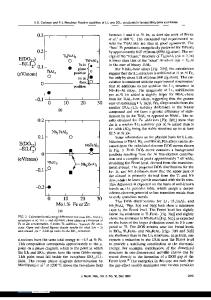Relative stability of LI 2 , DO 22 , and DO 23 structures in MAl 3 compounds
- PDF / 349,214 Bytes
- 4 Pages / 593.28 x 841.68 pts Page_size
- 83 Downloads / 261 Views
P. J. Meschter McDonnell Douglas Research Laboratories, P. O. Box 516, St. Louis, Missouri 63166 (Received 1 May 1989; accepted 18 May 1989) The structural energy differences between cubic Ll 2 and tetragonal DO22 crystal structures are calculated for MA13 compounds, where M is a group III, IV, or V transition metal. The stability of the DO22 structure relative to Ll 2 increases rapidly as the transition-metal d-electron count increases. Typical values of £(DO22) - E(Ll2) are 0.1-0.15 eV/atom (9600-14 500 J/g-atom) for group III, =s 0.05 eV/atom (=£ 4800 J/g-atom) for group IV, and ~ —0.2 eV/atom (~ —19000 J/g-atom) for group V trialuminides. Similar trends are calculated for the DO 23 /L1 2 energy difference. The calculated electronic densities of states (DOS) show that each structure has a minimum in the DOS distribution at a characteristic ^-electron count. The preferred crystal structure for a given compound is the one in which the Fermi level lies in the minimum.
Transition-metal trialuminides such as TiAl 3 and NbAl3 are technologically promising because of their low densities and high melting temperatures, which suggest high-temperature strength. Lack of ductility in these compounds (see, for instance, Ref. 1) has limited their applications. The best opportunity for intrinsic ductility in these or similar compounds, which often have tetragonal DO22 or DO23 crystal structures, is generally considered to be stabilization of the structurally similar, cubic Ll 2 structure (Fig. 1). The Ll 2 structure, unlike DO22 and DO 23 , has enough equivalent (111)(HO)-type slip systems to satisfy
1
o o
o o
"1 o
(b)
/ o o
o • o
o o (a)
y
o
o o o o
/
•M oAl
Q
\A
/
V i
/ o
o o o o
(
o
/ o /
a "
FIG. 1. Alternative crystal structures for MA13 compounds: (a) cubic Ll 2 , c/a — 1, (b) tetragonal DO 22 , ideal c/a = 2, and (c) tetragonal DO23, ideal c/a = 4.
1060
J. Mater. Res., Vol. 4, No. 5, Sep/Oct 1989
the von Mises minimum criterion for slip deformation in polycrystalline samples. Recent phase diagram studies on Ti-Al-M and Nb—Al-M systems have shown that TiAl3 (DO22) is readily converted to Ll 2 by small amounts of transition metals such as Fe, Ni, and Cu,2 while attempts to apply the same scheme to NbAl3 have been unsuccessful.3'4 The DO23 compound ZrAl3 has likewise been converted to Ll 2 by additions of Cr, Fe, Ni, or Cu.5 Cubic Ll 2 variants of ZrAl3 (Ref. 6) and HfAl3 (Ref. 7) have been produced by precipitation in cubic Al matrices with which they are coherent. Our purpose in this paper is to develop, by performing quantum-mechanical total-energy calculations, a systematic understanding of the physical factors affecting the relative stabilities of DO22, DO23, and Ll 2 crystal structures in trialuminides of the groups III, IV, and V transition metals. Previous calculations8 of the lattice stability of TiAl3, using techniques similar to those used here, showed that the DO22 structure has a lower energy than the Ll 2 structure by about 0.05 eV/atom (4800 J/g-atom), in agreement with experiment.
Data Loading...











